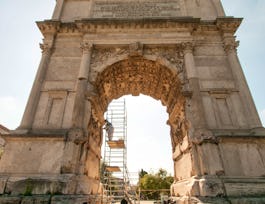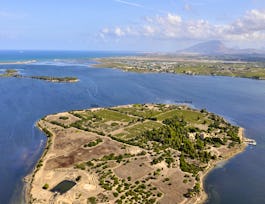Studying ancient - as well as medieval or modern - cities basically means telling local urban stories based on the reconstruction of changing landscapes through the centuries. Given the fragmentary nature of archaeological evidence, it is necessary to create new images that would give back the physical aspect of the urban landscape and that would bring it to life again. We are not just content with analyzing the many elements still visible of the ancient city. The connections between objects and architectures, visible and non visible buildings, which have been broken through time have to be rejoined, to acknowledge the elements that compose the urban landscape.


The Changing Landscape of Ancient Rome. Archaeology and History of the Palatine Hill
Taught in English
Some content may not be translated
14,557 already enrolled
(305 reviews)
Details to know

Add to your LinkedIn profile
8 quizzes
See how employees at top companies are mastering in-demand skills


Earn a career certificate
Add this credential to your LinkedIn profile, resume, or CV
Share it on social media and in your performance review

There are 8 modules in this course
As a welcome module, the course will start discussing how we can move back through time and space to draw an updated archeological chart of the Palatine, to be integrated when possible with missing or lost part of the ancient overall framework, in order to be turned into the basic tool for describing diachronically architectural and topographical continuity and discontinuity. This aiming at the reconstructions of sequences of facts and at a historical reconstruction tout-court. By the end of this module you will able to: - classify archaeological evidence - draw an archaeological chart - try to integrate missing part of buildings/monuments if possible
What's included
8 videos1 quiz
The whole story of city parts begins before the foundation of the city itself. In this module we will discuss how archaeological evidence and roman cultural memory allow to envision the faster and faster development from a number of dispersed peer communities to unified settlement, anticipating and somehow preparing the birth of the City. By the end of this module you will able to: - identify central Italian Bronze and Iron Age artifacts - define and identify pre- and proto-urban topographical and social organization - try to compare archaeological features and literary tradition
What's included
4 videos1 quiz
April 21st year 753 before common era. This is the day when the Romans believed their city had been founded. And they were probably right. According to the Roman foundation legend, a prince born in Alba Longa by a god and the young king’s daughter - Romulus - founded the city. He celebrated an elaborated rite on the Palatine, killed his twin brother - Remus - encircled the Palatine with a sacred wall, gave the Romans a constitution and reigned over the new born city for 37 years. Thanks to the results of our recent archaeological excavations we know now that the core of the legend is true. By the end of this module you will able to: - discuss present state of scientific debate about the birth of the city in Central Italy - define and identify urban political organizations - identify Late Iron Age and Early Archaic artifacts and building techniques.
What's included
4 videos1 quiz
Just one hundred and fifty years after the foundation, huts and pebble streets were substituted by more substantial buildings and paved streets. On and around the Palatine, as well as in other districts of the city, Houses and temples resting on squared blocks foundations and covered by roofs made of clay tiles replaced huts. Streets were paved by rock slabs and new drains allowed to keep lower areas dry, even during flooding winter seasons. In year 509 before common era, the king was sent into exile and two young aristocrats declared themselves first annual magistrates of a new State: the Roman Republic. From the 5th to the end of the 3rd century before common era, Rome had to fight to survive and the urban lay-out of the hill is not altered by relevant changes. By the end of this module you will able to: - discuss major changes occurred between the late archaic period, early- and mid- republican phases in Rome - define and identify a certain number of Roman monuments and/or places - identify Late Archaic and early/middle Repubblican artifacts, decorations and building techniques
What's included
4 videos1 quiz
In the course of nearly three hundred years – from 509 till 202 b.c.e. - central, southern and northern Italy were conquered by the Romans and included into the Roman political organization as submitted or allied territories. Later on, year 146 b.c.e. was the real turning point. Greece became a Roman Province. Carthage – a city in north Africa, Rome’s enemy number one – was destroyed. The Mediterranean sea was roman: Mare nostrum, they called it: “Our Sea”. The republican political system was still working but this was, in fact, the beginning of a new Empire. The luxurious residences of the most eminent civil and political actors - nobles, knights, senators, magistrates and so forth - were on the Palatine, “the most beautiful part of the City”. By the end of this module you will able to: discuss major changes occurred during the Late Republican phase in Rome define and identify a certain number of Roman monuments and/or places identify Late Repubblican artifacts, decorations and building techniques
What's included
4 videos1 quiz
Year 31 b.c.e. After nearly fifty year of Civil Wars, a 32 years old man, son of a sister of Julius Caesar, defeated his last enemy. Few years later - 27 and 23 b.c.e. – Roman Senators assigned him an immense power, asking him to watch over a new era of peace and respect for Roman laws and ancient traditions. They called him Augustus, a word meaning “blessed by Jupiter the king of the Gods”. The nephew of Julius Caesar became the first Emperor of Rome, and choose the Palatine as his own residing place. By the end of this module you will able to: - discuss major changes occurred between Late Republican phase and Augustan age in Rome - define and identify a certain number of Roman monuments and/or places - identify Augustan artifacts, decorations and building techniques
What's included
4 videos1 quiz
Imperial Rome was much more like a contemporary metropolis than we can imagine. Urban landscape, in particular on and around the Palatine, was crowded by: luxury residences and, first among them, the Imperial Palace on the Palatine; buildings for spectacles; baths: buildings for leisure and culture; temples and cult places for traditional gods and for new gods, that is the deified emperors; blocks of multiple storey buildings. This is how Rome should have looked like when poets and writers called her the “Golden City” (Aurea Roma). By the end of this module you will able to: - discuss major changes occurred during Early Imperial period in Rome - define and identify a certain number of Roman monuments and/or places - identify Early Imperial artifacts, decorations and building techniques
What's included
4 videos1 quiz
The embellishment of the city went on for a little further. At the beginning of the 4th century, Constantine the Great, first Christian Emperor, restored the imperial palace on the Palatine and also offered in different parts of the city monumental churches to the “new” God of the “new” Faith. The “Golden Rome”, even if wounded and besieged by the so-called “Barbarian People” pressing from East Europe and Middle East, still preserved her splendor. 476 A.D.: The German King Odoacre dethrones the last Roman Emperor, Romulus Augustus. 535 A.D.: Justinianus Emperor of Byzantium – once the capital of the eastern part of the Roman Empire - send a fleet and an army to Italy in order to “free Rome from the Barbarians”. 552 A.D.: 27 years later. War is over at last and the generals sent by Justinianus conquer Rome. But less than one thousand people lived in the urban area. Small churches, huts, small herb and vegetables gardens, tombs were scattered here and there in the vast area of the nearly empty city, between the skeletons of the ancient ruined buildings. By the end of this module you will able to: - discuss major changes occurred during Middle and Late Imperial period in Rome - define and identify a certain number of Roman monuments and/or places - identify Middle and Late Imperial artifacts, decorations and building techniques.
What's included
4 videos1 quiz
Instructor

Offered by
Recommended if you're interested in History

Yeshiva University

National Taiwan University
Why people choose Coursera for their career




Learner reviews
Showing 3 of 305
305 reviews
- 5 stars
60.65%
- 4 stars
23.60%
- 3 stars
9.18%
- 2 stars
3.27%
- 1 star
3.27%

Open new doors with Coursera Plus
Unlimited access to 7,000+ world-class courses, hands-on projects, and job-ready certificate programs - all included in your subscription
Advance your career with an online degree
Earn a degree from world-class universities - 100% online
Join over 3,400 global companies that choose Coursera for Business
Upskill your employees to excel in the digital economy
Frequently asked questions
Access to lectures and assignments depends on your type of enrollment. If you take a course in audit mode, you will be able to see most course materials for free. To access graded assignments and to earn a Certificate, you will need to purchase the Certificate experience, during or after your audit. If you don't see the audit option:
The course may not offer an audit option. You can try a Free Trial instead, or apply for Financial Aid.
The course may offer 'Full Course, No Certificate' instead. This option lets you see all course materials, submit required assessments, and get a final grade. This also means that you will not be able to purchase a Certificate experience.
When you purchase a Certificate you get access to all course materials, including graded assignments. Upon completing the course, your electronic Certificate will be added to your Accomplishments page - from there, you can print your Certificate or add it to your LinkedIn profile. If you only want to read and view the course content, you can audit the course for free.
You will be eligible for a full refund until two weeks after your payment date, or (for courses that have just launched) until two weeks after the first session of the course begins, whichever is later. You cannot receive a refund once you’ve earned a Course Certificate, even if you complete the course within the two-week refund period. See our full refund policy.




